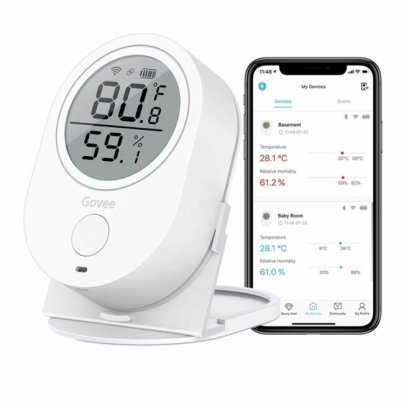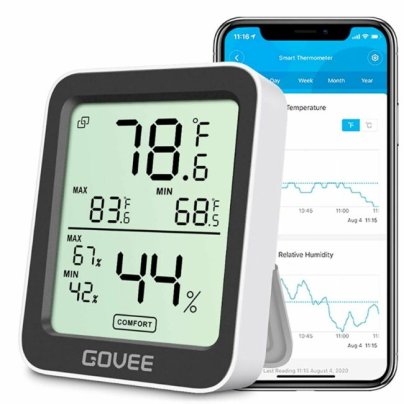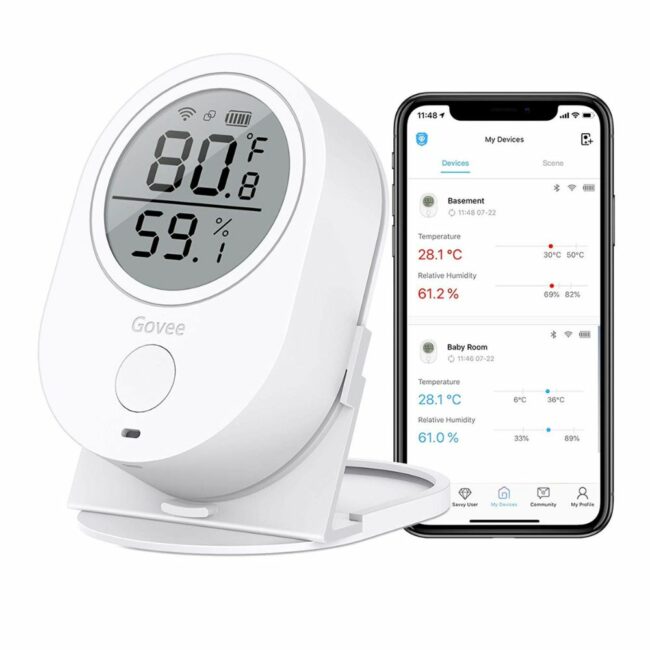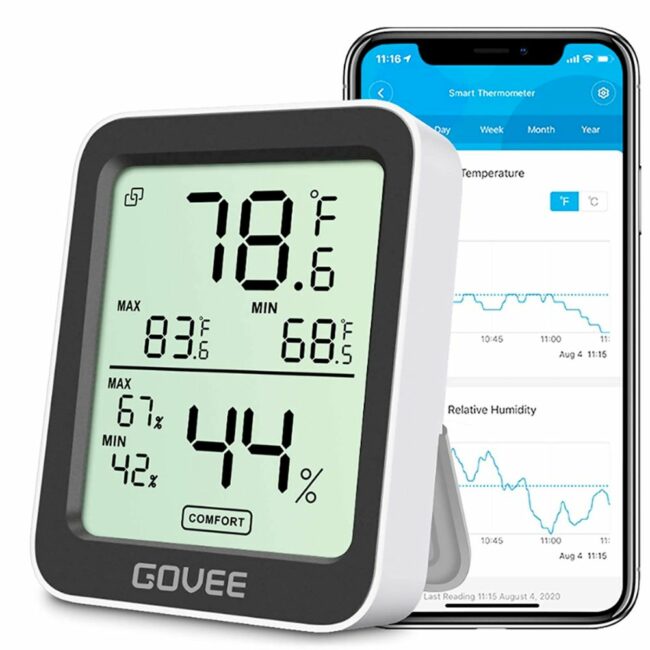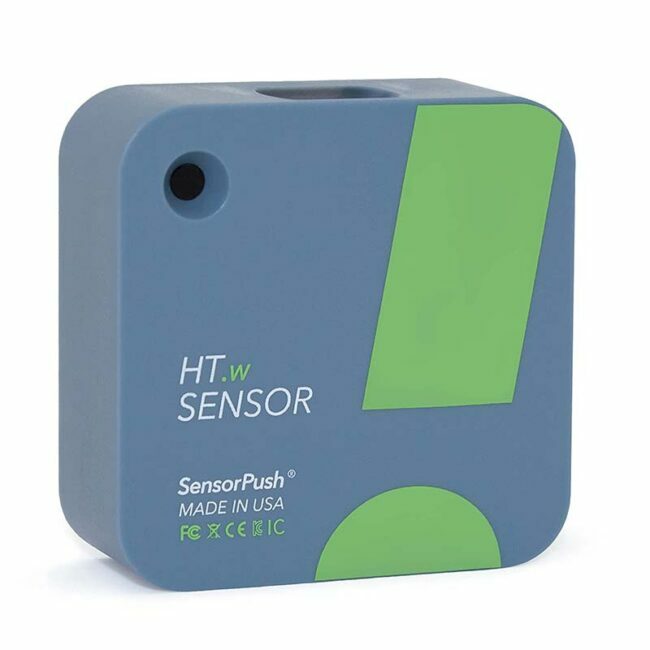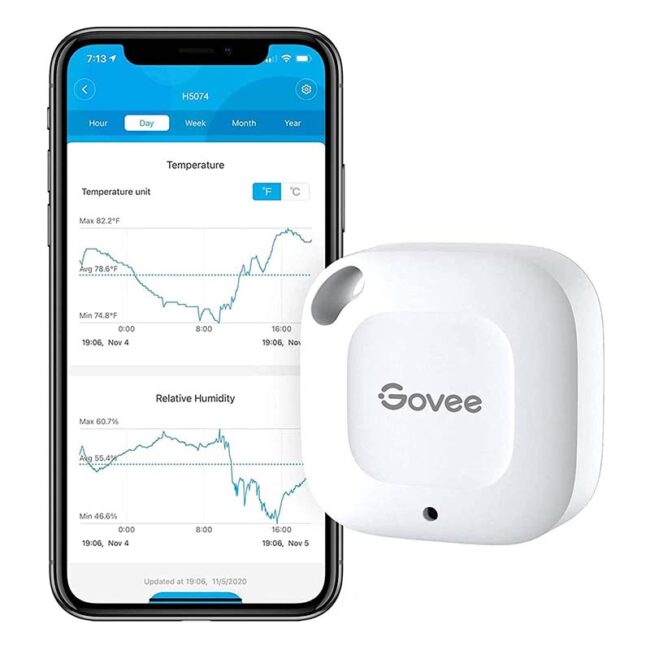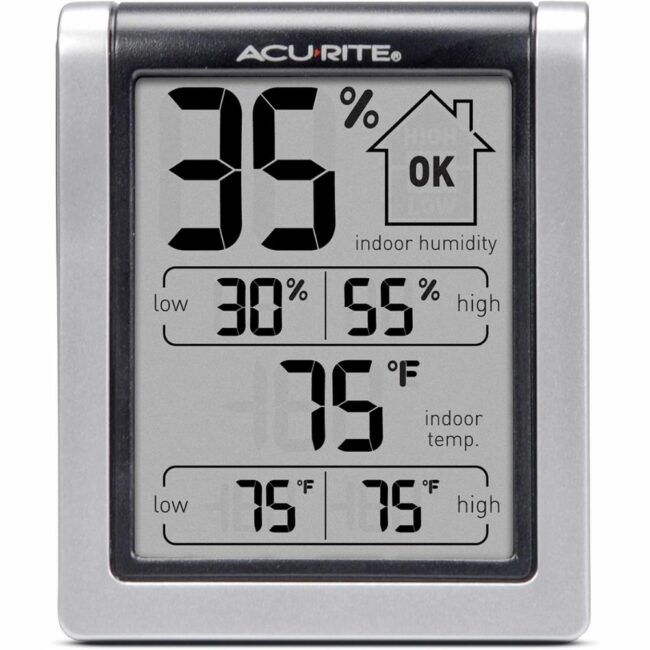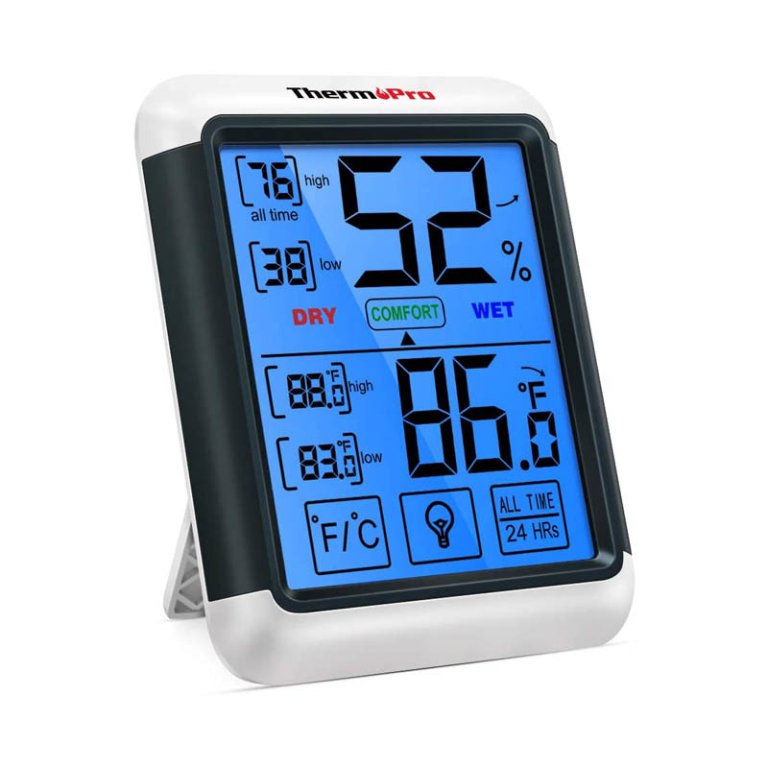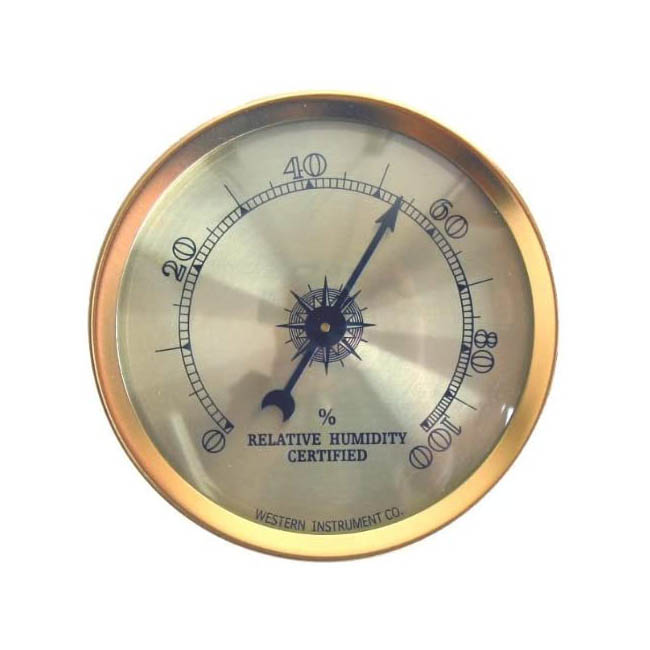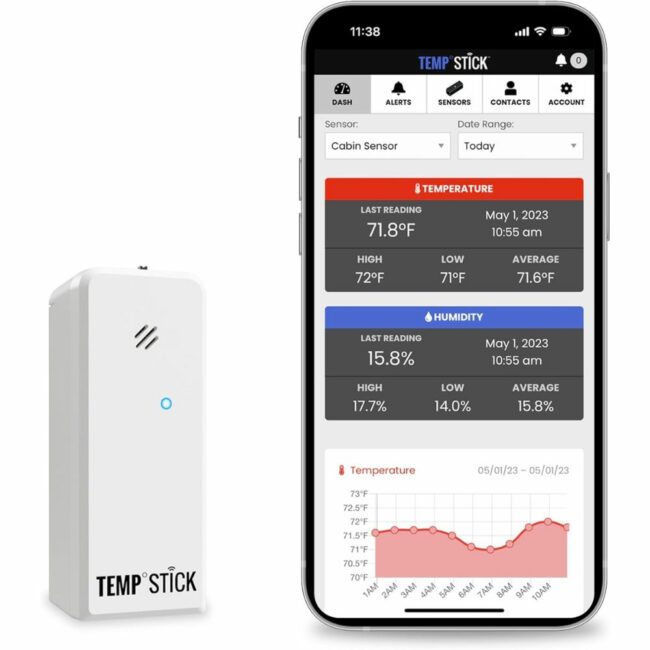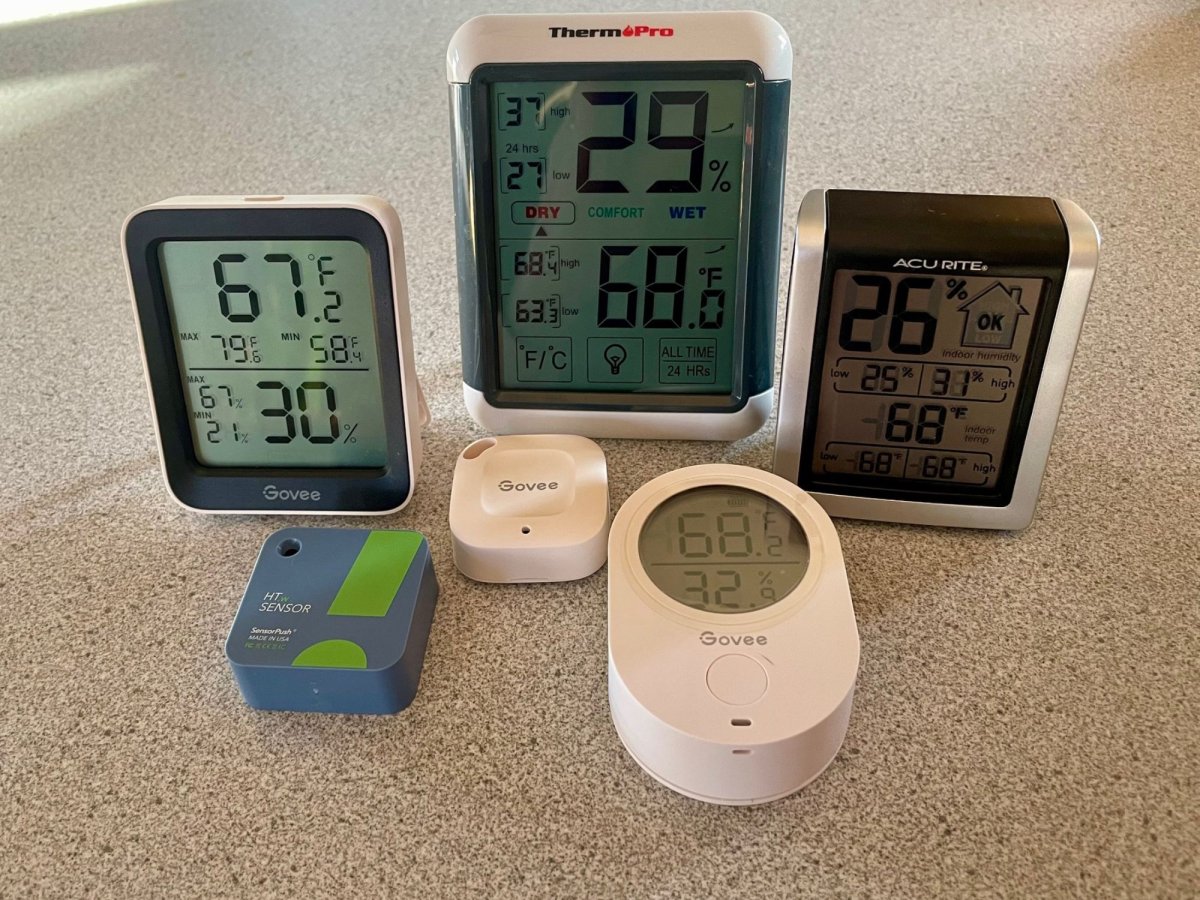
We may earn revenue from the products available on this page and participate in affiliate programs. Learn More ›
Hygrometers measure humidity—the amount of water vapor in the air—which impacts the health of people and plants, the preservation of treasured wood furniture and collectibles, and even the structural integrity of your home’s foundation. Just as with thermometers, however, these tools aren’t always 100 percent accurate. We spent a week testing six popular products to determine which hygrometers you can trust to provide reliable data.
Based on our test results and what we learned from our extensive research, we chose the Govee H5051 Wi-Fi Indoor Hygrometer as the best overall option for its ease of use, accuracy, and value. There was a lot we liked about the other products in our list of top picks, however, and one of those might be better for your needs. Below, learn more about how each of the best hygrometers performed in our tests and which features matter most when choosing one.
- BEST OVERALL: Govee H5051 Wi-Fi Indoor Hygrometer
↓ Jump to Review - BEST BANG FOR THE BUCK: Govee H5075 Bluetooth Hygrometer Thermometer
↓ Jump to Review - BEST SMART:SensorPush HT.w Temperature/Humidity Smart Sensor
↓ Jump to Review - BEST FOR GREENHOUSES: Govee Wireless Hygrometer Thermometer
↓ Jump to Review - BEST FOR INDOOR PLANTS: AcuRite Indoor Temperature and Humidity Monitor
↓ Jump to Review - ALSO CONSIDER: ThermoPro TP55 Digital Hygrometer
↓ Jump to Review - BEST FOR CIGARS: Cigar Oasis Western Analog Hygrometer
↓ Jump to Review - BEST FOR WINE CELLARS: Ideal Sciences Temp Stick Humidity Sensor
↓ Jump to Review
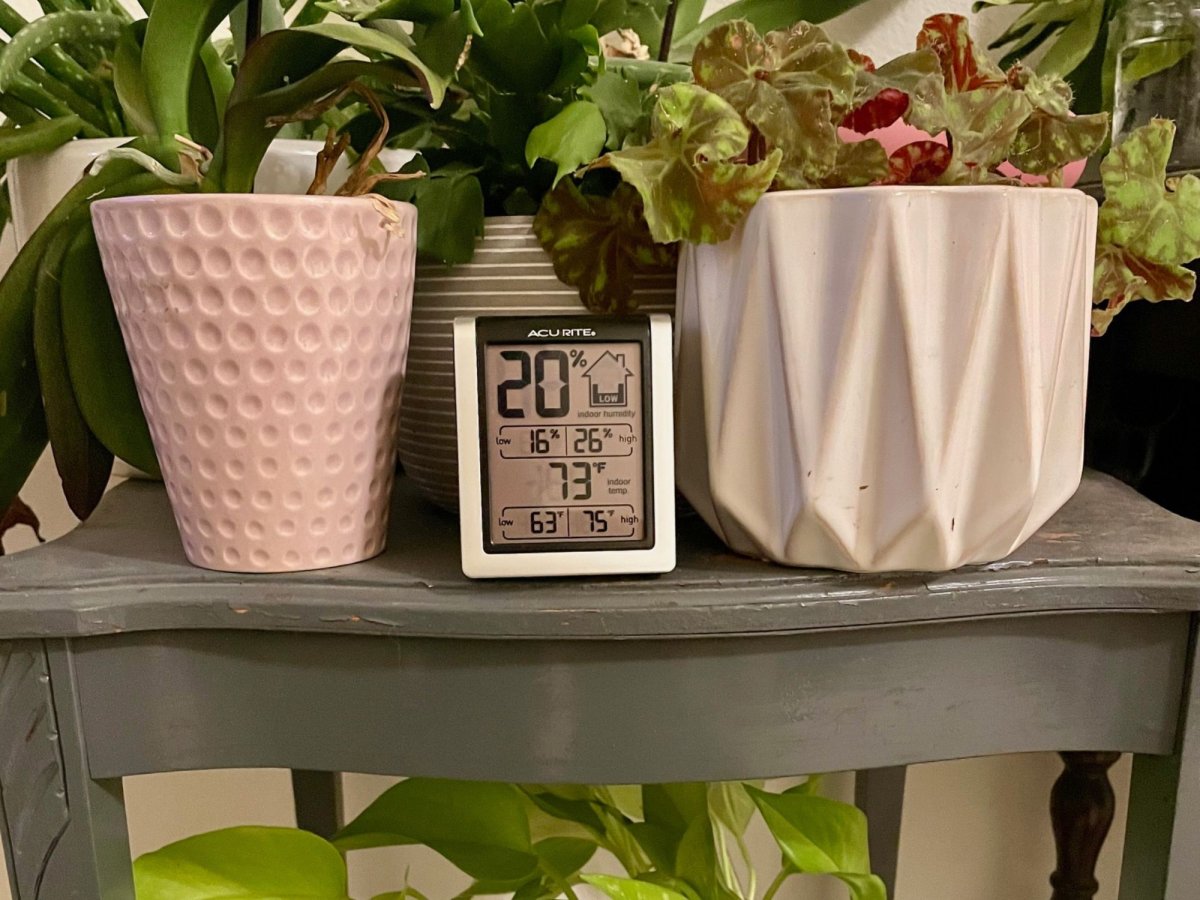
Hygrometer Comparison Chart
| Product Name | Digital/Analog | Humidity Accuracy | Temperature Accuracy |
| Govee H5051 Wi-Fi Indoor Hygrometer | Digital | 3 percent relative humidity | 0.54 degrees Fahrenheit |
| Govee H5075 Bluetooth Hygrometer Thermometer | Digital | 3 percent relative humidity | 0.5 degrees Fahrenheit |
| SensorPush HT.w Temperature/Humidity Smart Sensor | No onboard display; digital via app | 2 percent relative humidity | 0.36 degrees Fahrenheit |
| Govee Wireless Hygrometer Thermometer | No onboard display; digital via app | 3 percent relative humidity | 0.54 degrees Fahrenheit |
| AcuRite Indoor Temperature and Humidity Monitor | Digital | 3 to 5 percent relative humidity | 2 degrees relative humidity |
| ThermoPro TP55 Digital Hygrometer | Digital | 2 to 3 percent relative humidity | 1 degree Fahrenheit |
| Cigar Oasis Western Analog Hygrometer | Analog | 1 percent relative humidity | n/a |
| Ideal Sciences Temp Stick Humidity Sensor | No onboard display; digital via app | 2 percent relative humidity | 0.15 degrees Celsius |
Our Top Picks
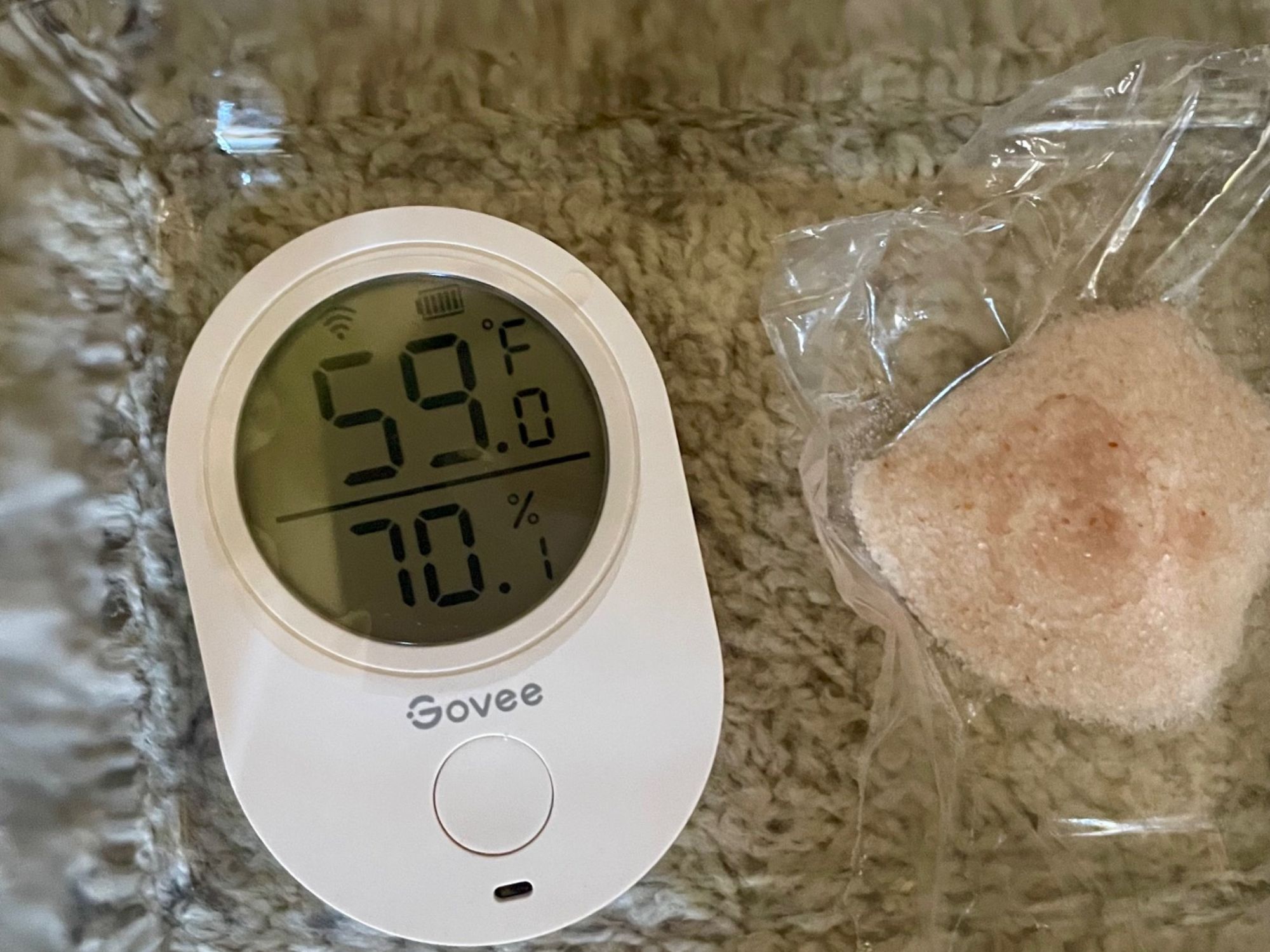
Our list of the best hygrometers includes straightforward devices and high-tech models. We suggest you review our test results as well as what we like and don’t about each product before choosing the right tool to measure your humidity level at home.
Best Overall
Govee H5051 Wi-Fi Indoor Hygrometer
See ItWhat We Like
- Digital face plus Bluetooth and Wi-Fi connectivity
- Excellent accuracy and ongoing monitoring
- Attaches to stand or mounts on wall
What We Don’t Like
- Doesn’t click into stand very solidly
Specs
- Digital/analog Digital
- Humidity accuracy 3 percent relative humidity
- Temperature accuracy 0.54 degrees Fahrenheit
Our Ratings: Setup 5/5; Functionality 4.8/5; Accuracy 5/5; Value 4.8/5
Govee’s H5051 is about as sleek and compact as digital display hygrometer thermometers come. But it’s more than simply a digital device: In addition to showing current temperature and humidity readings on its small round face, it also has Wi-Fi and Bluetooth functionality, allowing users to monitor conditions remotely via the Govee Home app. It comes with a small stand as well as a mounting plate and adhesive for attaching to the wall. The unit runs on an included CR247 battery for long-lasting operation (but somewhat annoying replacement) and features a four-bar battery meter on its display.
There was a lot to like about this Govee hygrometer during setup and testing. Of all the models we evaluated, this one was the closest to perfectly calibrated upon arrival. Adjusting its accuracy was incredibly easy through the app, which stores up to 2 years of data and can be set to refresh every 10 minutes or 30 minutes. You can view stored information by hour, day, week, month, or year, export the data as a CSV file for analysis, and set alarms for low battery, temperature, and relative humidity.
What our tester says: “This thermo hygrometer is compact, modern, and accurate. It’s one of the few we tested that both looks good and works well. I can’t say we use the smart features all that often, but I like being able to check the app for past data as well as the face of the device for current conditions.” —Michelle Larson, Product Reviews tester and writer
Get the Govee H5051 hygrometer at Amazon.
Best Bang For The Buck
Govee H5075 Bluetooth Hygrometer Thermometer
See ItWhat We Like
- Incredible value for a digital and smart device
- Face is large yet has a modern look
- Easy to calibrate through the app
What We Don’t Like
- Runs on disposable AAA batteries
Specs
- Digital/analog Digital
- Humidity accuracy 3 percent relative humidity
- Temperature accuracy 0.5 degrees Fahrenheit
Our Ratings: Setup 5/5; Functionality 4.8/5; Accuracy 4.75/5; Value 5/5
The Govee H5075 hygrometer and thermometer combo features a large LCD face with Bluetooth connectivity to display current humidity and temperature readings and enable monitoring within 196 feet. It’s accurate to within 3 percent humidity and 0.5 degrees Fahrenheit, updating every 2 seconds to maintain precise readings in sensitive environments. Like our pick for best overall, this Govee hygrometer arrived with near-perfect calibration and was easy to adjust via the Govee Home app. It also sends notifications if the temperature or humidity falls outside a preset range and stores exportable data for up to 2 years.
While this model seems similar to our best overall pick, there are some significant differences. This humidity detector runs on two AAA batteries and has a larger digital display, but isn’t quite as sleek as its competitor. The Govee H5075 connects via Bluetooth and lacks a Wi-Fi connection, which would make it more useful when monitoring humidity from afar. Finally, this model measures water vapor percentage in whole numbers only, whereas other models measure to the tenth or hundredth of a percent. However, this model is less expensive than many of the other tested models, so you’ll have to determine if this unit meets your needs for a lower cost than other models, or if the upgrades are worth the increased cost. If you’re looking for an accurate, reliable hygrometer for a reasonable cost, this is a great option.
What our tester says: “Once we were done with testing, we immediately hung this small hygrometer on a nail in our garage. We don’t park in that space, but we do keep our puppy’s kennel out there and use it as a workshop. With this model’s Bluetooth connection, we’re able to ensure both our sleeping pup and our cordless batteries are warm and safe.” —Michelle Larson, Product Reviews tester and writer
Get the Govee H5075 hygrometer at Amazon or Govee.
Best Smart
SensorPush HT.w Temperature/Humidity Smart Sensor
See ItWhat We Like
- Accurate readings to ten-thousandth of a percent
- Long-lasting CR247 battery
- Sensor membrane and O-ring seals for water resistance
What We Don’t Like
- Wi-Fi connectivity requires additional purchase
- No onboard display
Specs
- Digital/analog No onboard display; digital via app
- Humidity accuracy 2 percent relative humidity
- Temperature accuracy 0.36 degrees Fahrenheit
Our Ratings: Setup 4.5/5; Functionality 5/5; Accuracy 5/5; Value 4.2/5
When it comes to accuracy from a smart device, it’s hard to beat the SensorPush HT.w wireless thermometer and hygrometer. This sensor uses Bluetooth to provide a range of up to 325 feet, and its accuracy is within 2 percent relative humidity and 0.36 degrees Fahrenheit. Like our top pick, this unit was almost exactly accurate right out of the box and is easy to calibrate through the SensorPush app.
The SensorPush is a bit more expensive than other options, and requires users to purchase remote Wi-Fi monitoring at an additional cost. However, it also features water-resistant construction and measures temperature and humidity all the way out to a tens-thousandth of a percent rather than just a hundredth of a percent, so if precision monitoring to that degree is necessary, this option is an excellent choice. This unit also has unlimited in-app data storage, making it ideal for those looking to monitor changing conditions for more than just 2 years.
Get the SensorPush hygrometer at Amazon or SensorPush.
Best For Greenhouses
Govee Wireless Hygrometer Thermometer
See ItWhat We Like
- Excellent price for a smart hygrometer
- Range is up to 262 feet for remote monitoring
- Very accurate without additional calibration
What We Don’t Like
- No onboard display
- Bluetooth only
Specs
- Digital/analog No onboard display; digital via app
- Humidity accuracy 3 percent relative humidity
- Temperature accuracy 0.54 degrees Fahrenheit
Our Ratings: Setup 4.5/5; Functionality 4.5/5; Accuracy 5/5; Value 4.8/5
If you’re looking for an affordable way to monitor temperature and humidity in a greenhouse, cellar, or garage, this smart hygrometer from Govee is up to the task. Simply place the small sensor in your desired location, and it will track and report conditions through the Govee Home app. It features a Bluetooth range of 262 feet, making it suitable for folks looking for remote monitoring without relying on Wi-Fi. This ensures you can receive important alerts about heat, cold, or humidity as long as you are within range, even without an internet connection.
The small sensor is accurate to within 3 percent relative humidity and 0.54 degrees Fahrenheit, and though ours arrived incredibly well calibrated, making adjustments is easy in the app. You can also review current records via line and bar graphs or print out historical data for the last 2 years. Remember, however, that this unit doesn’t have a display, so the only way to use this hygrometer for plants and remote spaces is with the app.
Get the Govee wireless hygrometer at Amazon.
Best for Indoor Plants
AcuRite Indoor Temperature and Humidity Monitor
See ItWhat We Like
- Shows current readings plus lows and highs over 24 hours
- Can measure humidity levels between 16 and 98 percent
- Accurate within 2 degrees Fahrenheit
What We Don’t Like
- AA batteries aren’t included
- No way to calibrate
Specs
- Digital/analog Digital
- Humidity accuracy 3 to 5 percent relative humidity
- Temperature accuracy 2 degrees Fahrenheit
Our Ratings: Setup 4/5; Functionality 4.75/5; Accuracy 4/5; Value 4.5/5
Those who need an easy-to-use humidity measurement tool for indoor plants will find this model from AcuRite to be a suitable and budget-friendly option. It has a large digital display that shows the current temperature and humidity percentage as well as the highest and lowest humidity levels and temperature readings of the last 24 hours. It also has a cute house icon that indicates whether the humidity level is low, ideal, or high, making it simple for plant lovers to see if their babies need more or less moisture in the atmosphere.
According to the manufacturer, this digital hygrometer provides humidity readings with an accuracy of 3 to 5 percent and temperature accuracy of 2 degrees Fahrenheit between 32 and 122 degrees Fahrenheit. However, this hygrometer was the least precise of all the models we tested, without ours reading about 7 percent lower than actual levels, and it cannot be calibrated to improve the precision. Still, temperature readings are well within 2 degrees, and those looking to maintain a general range of humidity for plants will appreciate this model’s price and ease of use. It runs on one AA battery and can be mounted via clip or magnet or propped on its folding kickstand.
Get the AcuRite hygrometer at Amazon, Wayfair, or AcuRite.
Also Consider
ThermoPro TP55 Digital Hygrometer
See ItWhat We Like
- Shows current humidity and all-time highs and lows
- Indicates whether readings are increasing or decreasing
- Touch-screen backlight, folding kickstand, nail hole, and 2 magnets
What We Don’t Like
- Can’t be calibrated
Specs
- Digital/analog Digital
- Humidity accuracy 2 to 3 percent relative humidity
- Temperature accuracy 1 degree Fahrenheit
Our Ratings: Setup 4/5; Functionality 5/5; Accuracy 4.5/5; Value 5/5
If keeping track of humidity levels without a high-tech and connected app or smart-home interface is important, the ThermoPro TP55 digital hygrometer could be the right tool for you. This hygrometer has a 4-inch touch-screen display with large numerals that make it easy to check the temperature and humidity from several feet away. It also features an optional backlight that improves visibility in low-light settings.
Of all the hygrometer thermometers we tested, this one has the largest screen and biggest numbers. Like several others, it also shows whether temperature and humidity levels are increasing or decreasing and what the highest and lowest readings for both were in the last 24 hours (as well as all-time highs and lows for humidity). Our tests showed that the unit’s temperature readings fall within the manufacturer’s stated 1 degree Fahrenheit, but it’s about 5 percent off actual humidity levels and cannot be calibrated. We think it’s still likely to be accurate enough for most users, especially given its price and versatile mounting options.
Get the ThermoPro hygrometer at Amazon or ThermoPro.
More Great Options
Though we have yet to test these two products, we still want to include them for their unique features and excellent reviews.
Best for Cigars
Cigar Oasis Western Analog Hygrometer
See ItWhat We Like
- Easy-to-read dial with scratch- and fog-resistant face
- Attractive brass-style finish
- Magnetic mount ensures it stays put
What We Don’t Like
- Does not provide temperature readings
Specs
- Digital/analog Analog
- Humidity accuracy 1 percent relative humidity
- Temperature accuracy N/A
When it comes to monitoring a humidor’s humidity levels, analog hygrometers should be as much about style as they are about function. The mechanical hygrometer by Cigar Oasis has an easy-to-read nautical-themed dial, an aluminum case with a brass-style finish, and a sunburst-patterned center design.
This 2¼-inch round analog humidor hygrometer is accurate to within 1 percent but is easy to calibrate via an adjustment screw if necessary. It also has a magnetic mount and a scratch- and fog-resistant glass face. It does not, however, provide temperature readings.
Get the Cigar Oasis hygrometer at Amazon or Cigar Oasis.
Best for Wine Cellars
Ideal Sciences Temp Stick Humidity Sensor
See ItWhat We Like
- Takes readings via Wi-Fi for remote monitoring at home and away
- Sends texts, emails, and push alerts if issues are detected
- Tracks humidity between 0 and 100 percent
What We Don’t Like
- Expensive relative to other hygrometers
Specs
- Digital/analog No onboard display; digital via app
- Humidity accuracy 2 percent relative humidity
- Temperature accuracy 0.15 degrees Celsius
Big investments like wine collections and the wine cellars that hold them are best protected with a Wi-Fi hygrometer that can keep their owners up to date and ensure conditions remain consistent. The Ideal Sciences Temp Stick wireless remote hygrometer can monitor temps between -40 degrees Fahrenheit and 140 degrees Fahrenheit and humidity levels across the full spectrum of 0 to 100 percent. If current conditions fall outside the user’s preset ranges or the device goes offline due to an internet outage,the device can send email, text, and push notifications alerts if the user chooses to set those up.
This battery-powered hygrometer does not have a digital display, but the Temp Stick app is compatible with iOS and Android devices or is accessible via web browser. It also allows users to customize automated daily, weekly, and monthly email reports for ongoing tracking, and stores readings indefinitely with unlimited data logging. All of this does come at a cost, however, as this model is fairly expensive.
Get the Ideal Sciences hygrometer at Amazon or Temp Stick.
Jump to Our Top Picks
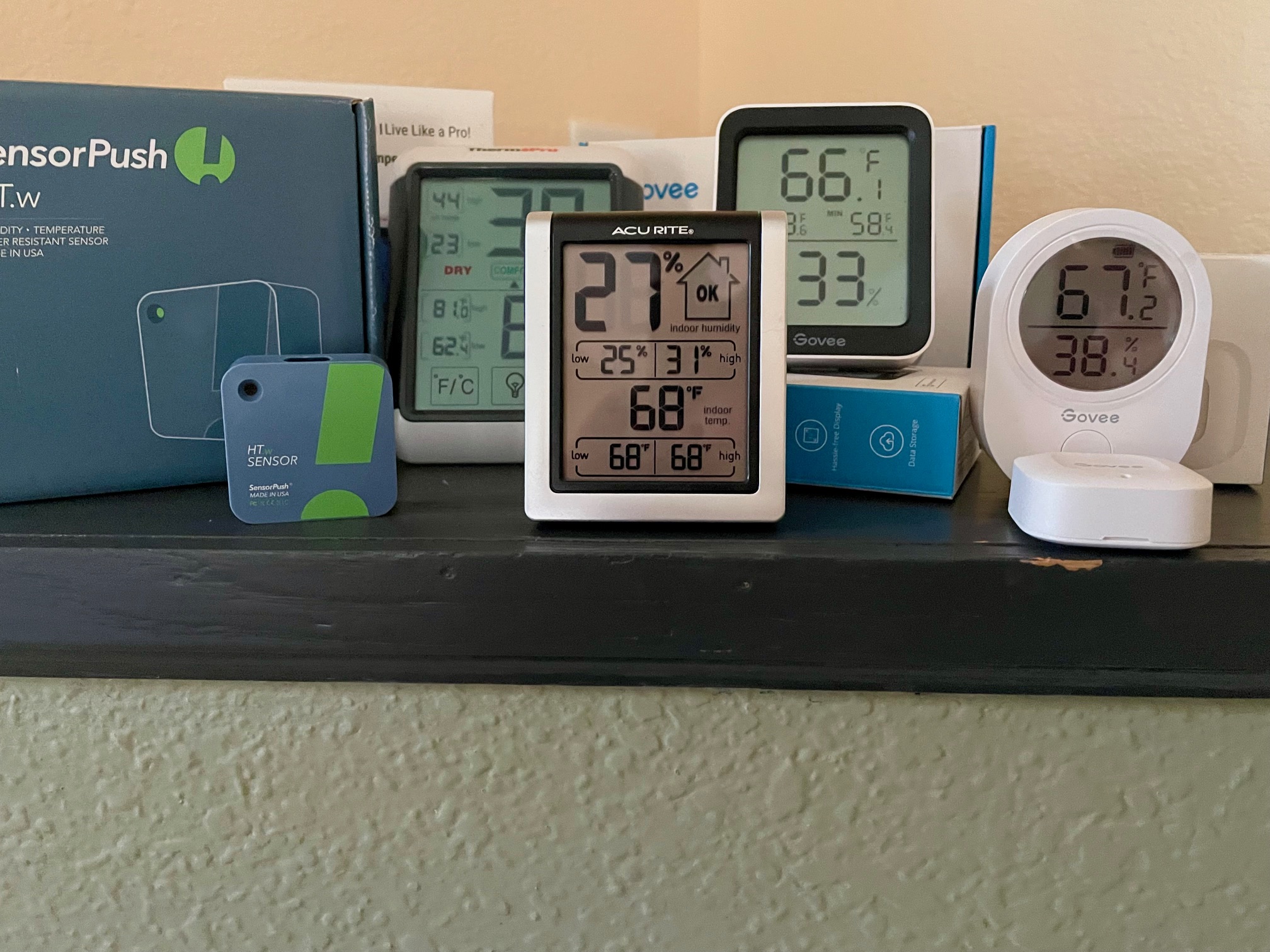
| Testing Stats | |
| Products tested | 6 |
| Time spent testing | 1 week |
| Tests performed | 8 |
| Price range | $100 to $150 |
Our Ratings: Hygrometers
| Product Name | Setup | Functionality | Accuracy | Value |
| Govee H5051 Wi-Fi Indoor Hygrometer | 5 | 4.8 | 5 | 4.8 |
| Govee H5075 Bluetooth Hygrometer Thermometer | 5 | 4.8 | 4.75 | 5 |
| SensorPush HT.w Temperature/Humidity Smart Sensor | 4.5 | 5 | 5 | 4.2 |
| Govee Wireless Hygrometer Thermometer | 4.5 | 4.5 | 5 | 4.8 |
| AcuRite Indoor Temperature and Humidity Monitor | 4 | 4.75 | 4 | 4.5 |
| ThermoPro TP55 Digital Hygrometer | 4 | 5 | 4.5 | 5 |
How We Chose and Tested the Best Hygrometers
Testing how accurately the above hygrometers measure humidity required us to calibrate each device before we could do anything else. This YouTube video details the process, but the short synopsis is that we put a small amount of salt and hot water next to each hygrometer in an airtight container and left them alone in a closet for 24 hours. We then checked their readings and determined how accurate they were. We adjusted the models that allow calibration and noted how far off the other units were.
We then tested each unit over for at least 5 days and as long as several weeks, setting them up next to each other indoors, outdoors, and in the bathroom after showers. We kept handwritten logs and downloaded dozens of CSV files, checking for quick response time to changing conditions and overall accuracy regarding humidity and temperature readings. For Bluetooth and Wi-Fi units, we monitored connectivity at half range and maximum range, noting whether walls affected accuracy.
What to Consider When Choosing a Hygrometer
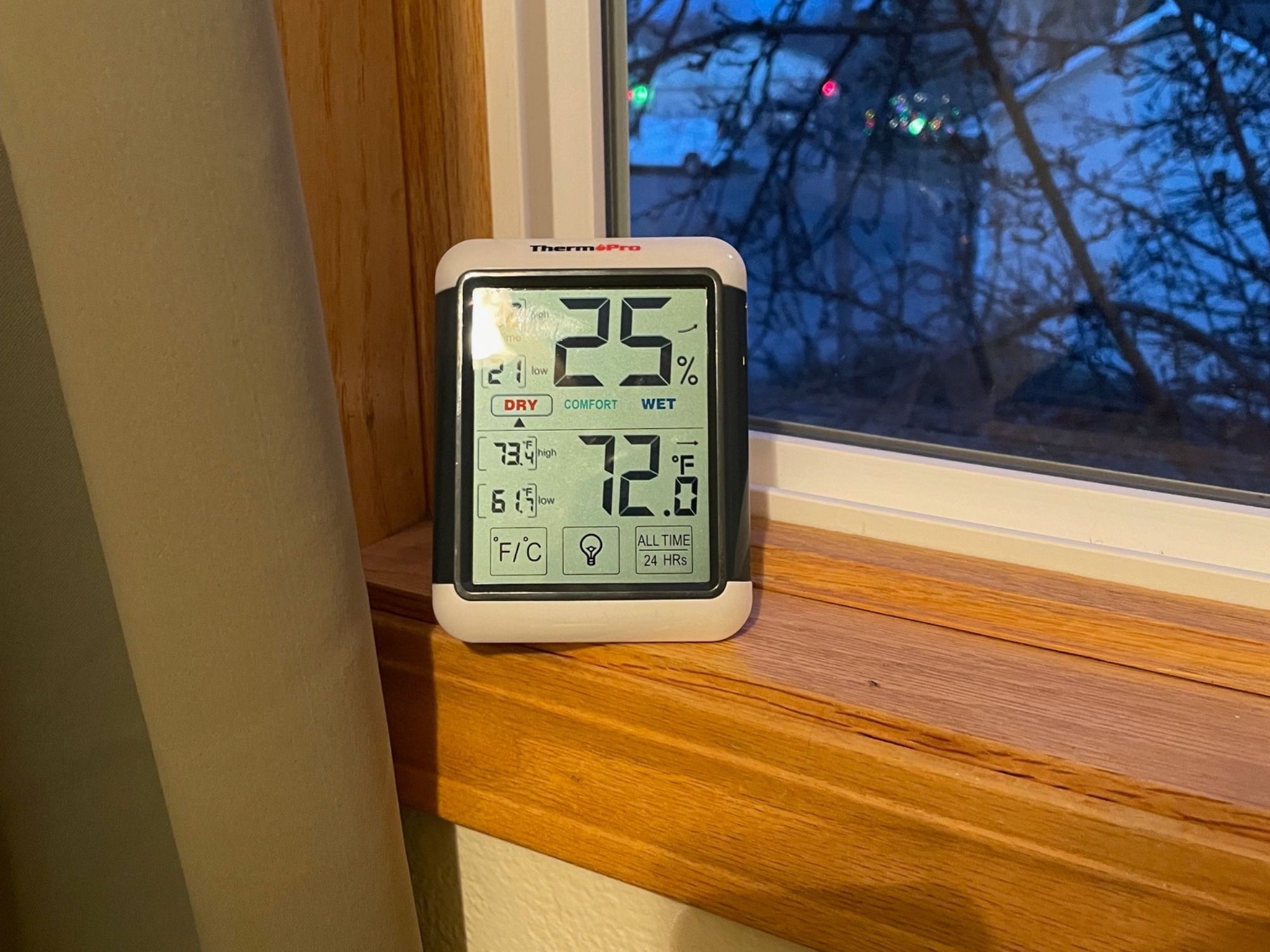
Beyond HVAC efficiency, maintaining proper humidity levels can improve health by helping to keep sinuses clear and making it easier to breathe. Accurate humidity control is also essential for protecting wine, cigars, plants, and keepsake items.
Choosing the best hygrometer requires careful consideration. Begin by determining where you will use the device, as indoor and outdoor hygrometers will have different features. Then consider whether you need advanced features like smart connectivity, unlimited data storage, or extended battery life—or if simply knowing the current conditions is all that matters.
Types of Hygrometers
Hygrometers come in several variations, but each is effective at sensing and displaying the humidity in a given environment. While the most popular hygrometers are electrical or mechanical, dew point hygrometers and psychrometers are worth learning about to appreciate the science behind these instruments.
Keep in mind that many hygrometers also display the temperature to serve as indoor thermometers as well. This can be particularly helpful in food storage spaces or wine cellars.
Electrical
Electrical hygrometers are the most widely used and high-tech hygrometers available. These devices measure the changes in electrical resistance across a semiconductor or sensor that reacts to the air’s moisture content. As the moisture content changes, the resistance increases or decreases, which the hygrometer displays digitally.
Today, most electrical hygrometers use batteries for power. Several models have Bluetooth connectivity, allowing users to check the hygrometer’s readings from the convenience of their smartphone. Others may operate on the home’s Wi-Fi, alerting the user to the conditions in the home so they can run a humidifier or dehumidifier to adjust the levels.
Mechanical Hygrometers
Anyone who’s perused the tables at a child’s science fair has probably seen a mechanical hygrometer. This popular science project uses the changes in organic materials caused by moisture content to display humidity levels.
In their simplest form, mechanical hygrometers use organic materials like oxgut or human hair to control a needle that points to a humidity scale. When the moisture content in the air rises, the organic material absorbs the moisture, contracting and becoming heavier, which in turn raises the needle. As the air dries, the material becomes lighter and stretches a bit, allowing the needle to fall.
Dew-Point Hygrometers
Moisture condenses on the polished-metal mirrors of dew-point hygrometers. By noting the air temperature at which water begins to condense on the mirror, experimenters can determine the dew point. To provide accurate readings, these devices require extremely consistent conditions, including constant atmospheric pressure and constant vapor content.
Dew-point hygrometers are very old-school technology, with the first invented in 1751. They aren’t used much, if at all, anymore, but modern hygrometers owe a bit of credit to this early device.
Psychrometers
While psychrometers don’t adorn the windows of many kitchens or greenhouses, they are still in use in meteorology. They’re also popular in wildland firefighting for detecting the danger and potential for a fire.
Psychrometers use two types of thermometers to measure the air’s moisture content. It’s a rather complicated process that involves wrapping one of the thermometers in a wet cloth and spinning both thermometers. The experimenter then enters the readings from the thermometers into an equation to determine the humidity level.
Application
How you intend to use a hygrometer makes a significant difference when choosing the best model. For instance, users may want a different product to monitor the humidity level of a greenhouse than to check on the conditions inside a reptile tank.
For most situations, a digital hygrometer that users can place on a bookshelf or table will serve just fine. However, some might prefer a minuscule hygrometer or one that operates without a battery for niche needs and applications.
Accuracy
On the whole, hygrometers are relatively reliable and consistent instruments. The most accurate hygrometer models are within 5 percent of true values. Beyond that, accuracy comes down to calibration.
Folks who suspect their hygrometer’s accuracy might be off a bit need to calibrate it. They can purchase a hygrometer calibration kit, which requires placing the hygrometer in a sealed bag for a prescribed length of time. The hygrometer reading relative to the kit’s percentage will determine if it needs calibration. Digital hygrometers may have calibration knobs or reset buttons, smart hygrometers are typically easy to adjust via app, and most analog hygrometers have adjustment screws in the back.
Digital vs. Analog
When it comes to reading a hygrometer quickly from a distance, it’s hard to beat an analog hygrometer. These mechanical hygrometers have needles that point to the general range on the dial, which is all folks need in most scenarios. The drawback of an analog dial is that it’s hard to tell the exact reading even up close, and these devices cannot measure more precisely than a full percent, while digital hygrometers can measure a tenth, hundredth, or even a thousandth of a degree. While this level of precision isn’t necessary for most users, it may be for some.
Digital displays are the choice to go with when it’s important to know the exact value of the humidity. With an electric hygrometer’s digital display, if the moisture begins to change, users will likely notice it sooner and more easily. The numbers will change as opposed to tiny movements from a needle. The downside is that low-quality or small digital displays can be challenging to read, as some digits can be hard to decipher from one another from a distance.
Power Source and Battery Life
Some countertop-style hygrometers come with 110V electrical adapters that plug into an outlet for unlimited runtime, although most run via battery power, with battery life lasting 6 months or more. Some models use rechargeable batteries, which can be particularly handy as long as the battery life lasts for a significant period of time.
Longer battery life may be especially important for remote monitoring using Wi-Fi or Bluetooth-enabled devices. For instance, when tracking plant humidity in a terrarium that needs to be kept closed as much as possible, it’s important to get a terrarium hygrometer sensor that’s thrifty with battery life.
Remote Monitoring and Alerts
Monitoring humidity levels isn’t always about personal comfort or convenience. Sometimes, it’s required by a favorite hobby or pursuit. For instance, monitoring a wine cellar or cigar humidor’s humidity level can be the difference between maintaining a wonderful selection or spoiling an expensive collection, and some wood musical instruments require precise humidity levels to avoid cracking that will destroy them.
For help keeping these areas within a crucial humidity range, it’s worth purchasing a hygrometer that relays data to a smartphone or a remote display. Most important, perhaps, is the ability to set a particular range and send alerts when the humidity is outside that range, which can help users take action before their cache spoils or molds.
Interconnectivity and User Interface
Thanks to advances in Bluetooth, Wi-Fi, and smart-home technology, there are plenty of options for connecting a hygrometer with personal technology.
Many of these devices use their own apps, allowing users to monitor the humidity levels via Bluetooth from a smartphone. This can be a great help when trying to avoid opening a sensitive environment like a greenhouse or terrarium. However, be aware that not all apps are equal in usability and function, so check into this before deciding on a compatible hygrometer.
From a smartphone, hygrometer users can access temperature and humidity readings in their homes when they’re not even there by using a WiFi-enabled app. Some of the best hygrometers can interact with smart-home devices, too. They provide their readings via Alexa, Google Assistant, or other digital assistants. If the user can access a home thermostat from their smartphone, they can adjust the home’s temperature settings based on information from the hygrometer’s app.
Data Logging
Those who are serious about controlling the humidity in their homes for health reasons, hobbies, or any other purpose need to collect data. They might want to consider a hygrometer that keeps a log of humidity values and temperatures. They can track that data and stay ahead of seasonal or environmental trends, maintaining a more consistent environment.
Some devices keep data logs in their apps, so users will have up to 2 or more years’ worth of information at their fingertips. Even more helpfully, they can export a spreadsheet of this critical data, which they can then store on a computer or print out.
FAQs
If you have condensation on windows or need to increase humidity for sinus health, answers to the following frequently asked questions might help you use a hygrometer to keep air vapor levels appropriate.
A main living area is usually the best place for a hygrometer. Moisture created by a kitchen or bathroom can temporarily make your house very humid, so it’s best to keep your hygrometer in a dryer room unless you’re specifically interested in managing the humidity fluctuations near those rooms.
Using a calibration kit, you can determine how far off your hygrometer is before calibrating it. Analog hygrometers have adjustment screws in the back of the gauge that you can manipulate to adjust the reading. Digital thermometers have adjustment knobs that you can dial to the proper humidity level. Smart hygrometers are generally adjustable via app.
If you need to add some moisture to the air, you can use a humidifier, which emits water vapor into the air. If you need to decrease your humidity levels, even a small dehumidifier will help. These machines pull air in, remove the moisture, and release the dryer air into the environment.
To check if your hygrometer is working, place it in an airtight container with a bottle cap full of salt and a small splash of water. After several hours, you should notice a difference in the hygrometer’s readings.
Indoor relative humidity should ideally be kept between 30 and 50 percent. If you live in a dry climate or you notice the air needs more moisture during certain seasons, using a room humidifier can help. If you need help getting humidity levels lower, check out the tips in our guide on how to lower humidity in your house.
Meet the Tester
After growing up an avid swimmer, working in a greenhouse throughout college, and moving to the top of a mountain with her husband and daughter, Michelle Larson is no stranger to a range of humidity levels. Having learned the importance of a reliable hygrometer firsthand, she firmly believes in the importance of testing popular options to help readers find accurate and user-friendly models.
Additional research provided by Tom Scalisi.
